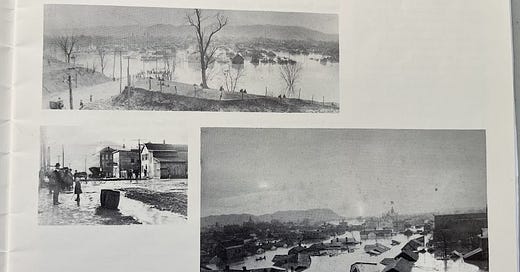PORTSMOUTH, OHIO — A permanent barrier to protect flood-ridden Portsmouth was the brainchild of J. L. Hudson, a former city engineer. Or at least it was Hudson who got the credit.
However, people did not initially warm to his idea. In fact, as one history said, Hudson “was scoffed at by many.”
Due to the devastating floods of 1884 and 1907, Hudson conceived a new defense for Portsmouth. The engineer wrote a letter to the city council in which he proposed that the city build a floodwall that would shield Portsmouth from an Ohio River stage up to 62 feet.
The councilmen were not bowled over by the plan, but Hudson was undeterred. He recruited important businessmen. The city council came around.
Gertrude Hood remembered 1907. “That was what we called a boot flood.” Her father was employed at Anderson’s on Third Street and walked home at noon to eat lunch. “[Dad] had hip boots,” Gertrude said, “... and he’d take me boot riding. He’d walk down the sidewalk with me on his shoulders … boot riding.”
The city council voted to approve an expenditure of $35,000 for the new flood defense project. The money was earmarked for the construction of a floodwall from Chillicothe Street to Scioto and Second streets at the city’s vulnerable corner where the Ohio and Scioto rivers met. In addition, “earthen embankments” (levees) would be built along Portsmouth’s western perimeter near the Scioto River.
Construction of a concrete floodwall began in 1908, as well as the installation of five pump stations. In 1930 the 62-foot barrier was extended to a distance of three miles, costing an additional $750,000. Two pump stations were added.
Portsmouth had erected nearly 16,000 feet of concrete wall and earthen levee.
J. L. Hudson would surely be pleased to see all of south-facing Portsmouth tucked behind such a long and sturdy barrier. And Portsmouth citizens also must have given silent thanks, especially when they heard rainfall for days at a time. In the minds of many people, the flood threat had been removed.
Impressive Infrastructure
Portsmouth’s infrastructure was ahead of its time. In particular, the flood control and drainage systems were regarded as an engineering marvel. People from beyond the region took notice.
At seven locations in the city, underground sewer lines joined pump stations, at which concrete reservoirs collected water. Pumps routed reservoir water into discharge pipes that sent it through the floodwall or the levees and into the neighboring rivers.
If the Ohio River climbed to a stage of about 45 feet, the sewer-line valves were closed (since this was the approximate discharge level), preventing the Ohio from seeping into Portsmouth through the sewer system. With the discharge pipes shut off, the pumps handled the city’s drainage, which pooled into the reservoirs.
The pump stations helped keep rain, sewage and other drainage from creating a flood inside the floodwall and levees.
Staying Dry During Major Floods
It seemed the floodwall upgrade was completed just in time. The Great Depression years brought two big floods to Portsmouth’s doorstep.
On March 22, 1933, the Ohio River crested at 60.8 feet, but the Portsmouth floodwall held back the river with more than a foot to spare, “its sternest test” to date.
Another big flood arrived in 1936, cresting at 59.2 feet on March 23. A small amount of water from the Scioto River leaked onto the northern point of Market Street and covered yards in the vicinity of Jefferson and Fourth streets. Fewer than 25 families were evacuated.
“Among all the cities from Pittsburgh to Cairo, only Portsmouth remained relatively dry — even though much of the city was … below the level of the river,” recalled River at the Door.
While people elsewhere fled from the Ohio River, it was business and life as usual in Portsmouth. The city’s defense had stopped two massive floods that would have extracted a much heavier toll than in 1884 and 1913.
According to an estimate by city officials, in 1933 and 1936 the floodwall had shielded Portsmouth from a million dollars in losses. In other words, it had paid for itself. This got the attention of engineers across the nation and a film crew from Hollywood.
“When flood disaster struck the entire Midwest in 1936, [Portsmouth’s] flood defenses held back the river and the floodwall became a symbol of invincibility.”
— River at the Door
Judging from a souvenir postcard of that time period, the floodwall was a landmark and source of civic pride. The color postcard shows a portion of the floodwall lined with trees along Portsmouth’s riverfront. Barges and small boats are seen on the river.
By January 1937 the Ohio River had exceeded 60 feet at Portsmouth on four occasions since the 1907 flood. As one history said, “and now Portsmouth was safe behind a 62-foot floodwall.” The city, declared a newspaper in 1936, was “flood-proof.”
Thank you for reading. If you liked this installment, please click the 🤍. Access the archives for the full chronology of The 1937 Flood Journal.







The city was floodproof... sounds a lot like a ship being unsinkable... I'm already saddened by the damage I'm expecting to read about in Portsmouth soon.
What a fascinating bit of infrastructure--the closing of the sewer valves and using pumps when the water level got high was especially interesting! Though the entire time I was reading, I was waiting for the other shoe to drop...will the 1937 flood exceed the 62 foot threshold? Looking forward to the next installment!